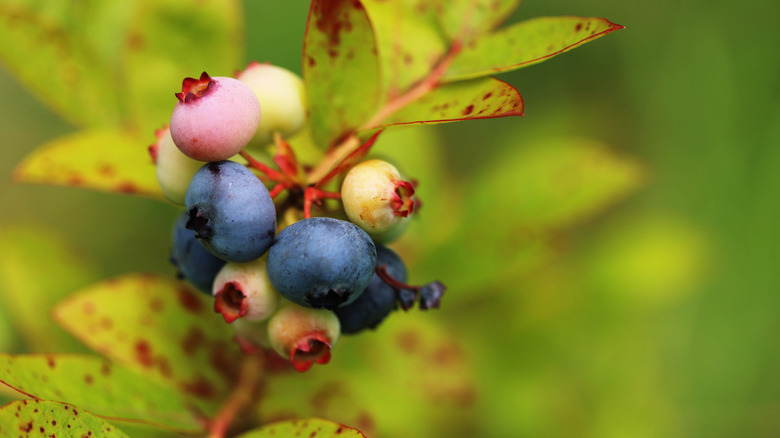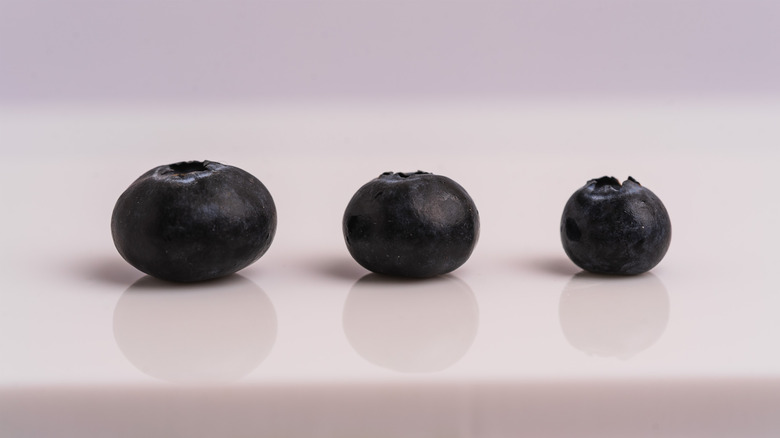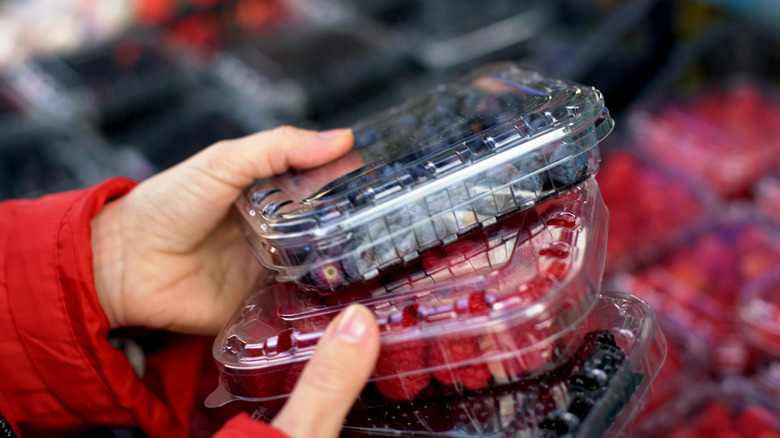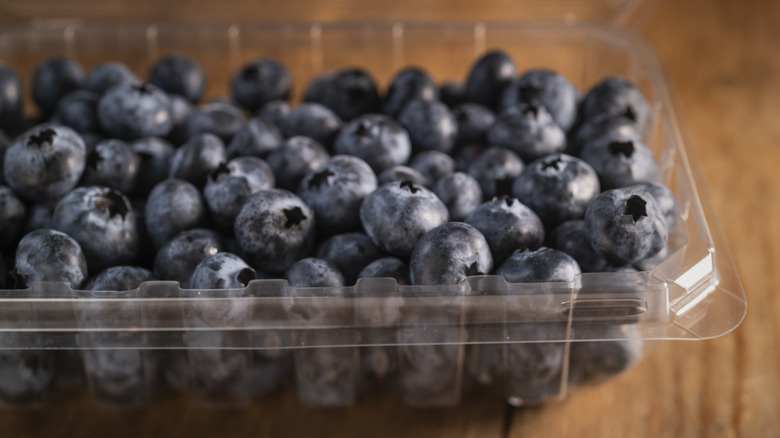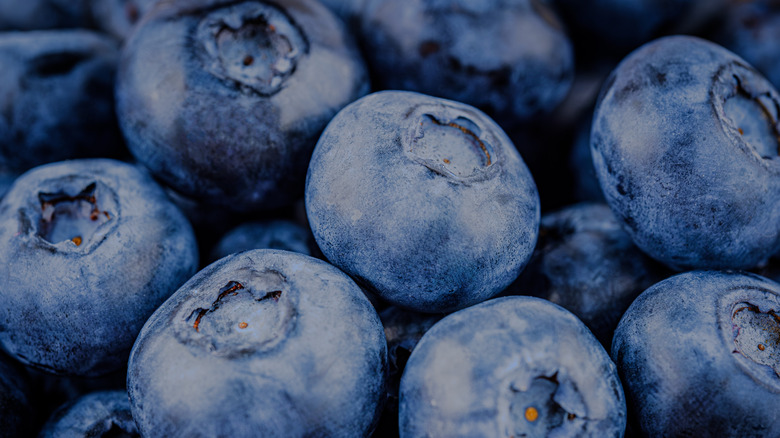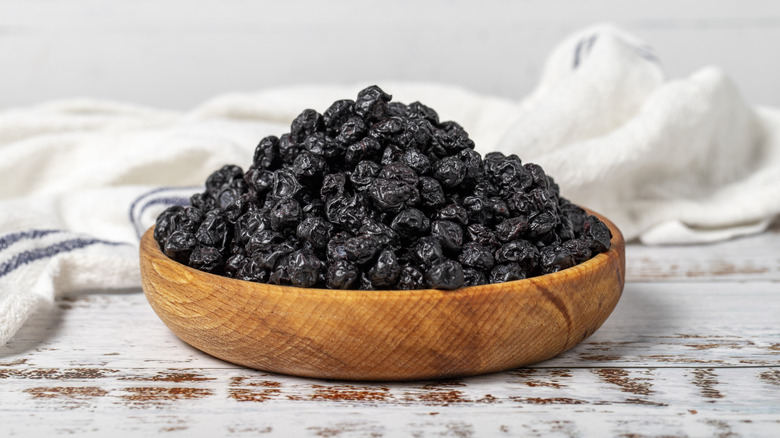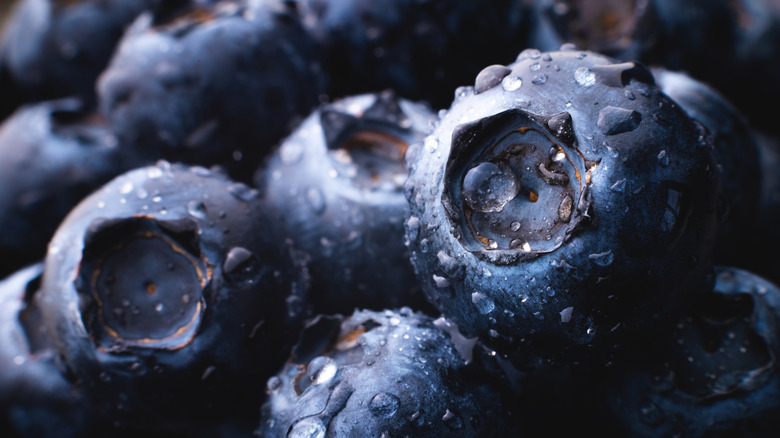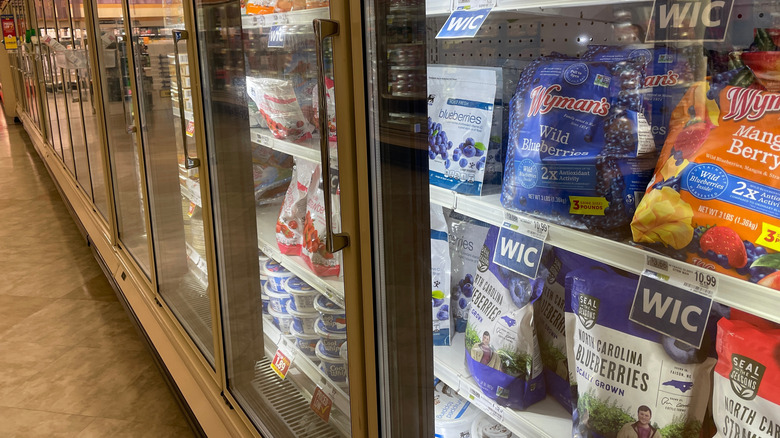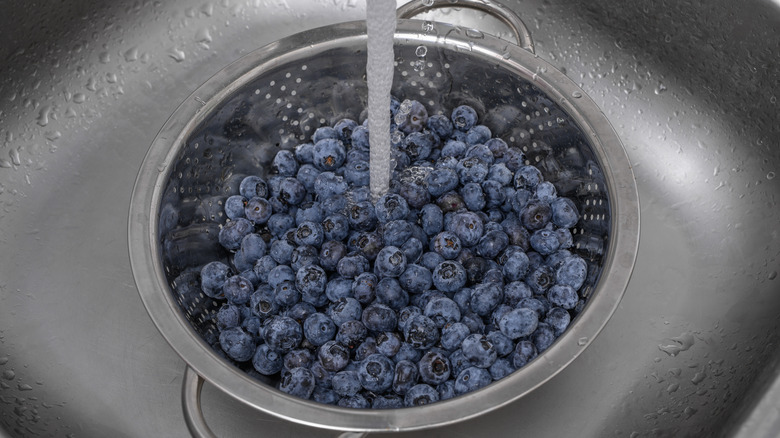Common Mistakes People Make When Purchasing Blueberries
Like strawberries, raspberries, and blackberries, blueberries reach peak season in most areas over the summer months — and many berry-lovers count down the days all year long. These sweet, antioxidant-packed morsels are not only healthy but also delicious. From serving as the perfect snack to salad topping to amping up your favorite baked goods, blueberries are a versatile ingredient you can use in countless different ways — especially once you're caught up on everything you need to know about this vibrant fruit.
Though you may be well-versed in the different ways to prepare and serve blueberries, there may be one stage of the process you're overlooking: picking out the fruit. When shopping for blueberries, there are a few things you should be conscious of to ensure you get the best batch possible. Learn more about the common mistakes people make when purchasing blueberries so you can avoid these pitfalls on your next shopping trip.
Not inspecting the color
The color of your blueberries likely corresponds directly to their flavor — so it's important to assess the container carefully before adding it to your grocery cart. As a general rule of thumb, the darker the berry, the sweeter it is. For blueberries, that means that a deep purplish-blue hue will probably give you a nice sweet, ripe flavor.
If you prefer more tart or sour berries, look instead for blueberries that are a more reddish or pink hue. While this color indicates that the berries were picked before peak ripeness, some people may enjoy this taste and can search for these vibrant shades among the pints of berries at the grocery store.
Whichever hue you prefer, be sure to look for a container of berries that is also uniform in color. Finding berries that were all picked at a similar level of ripeness will help prevent some berries going bad before the others, making it easier to use up your container before they begin to rot or get moldy.
Buying them out of season
Like with all fresh fruit and vegetables, buying blueberries in season helps you maximize the likelihood of ripe, delicious berries. Luckily, blueberries have a long season compared to many other types of produce, making it possible to get them at peak freshness from spring until early fall in the U.S.
While hotter regions like the South start their harvests earlier and reach peak season by early June, other cooler regions, like New England, don't reach peak season until September. Though blueberries are native to North America, they are also farmed in South America (including Peru, Chile, Mexico, and Argentina), where they reach peak ripeness anywhere from November to March. This helps to ensure that ripe blueberries are accessible nearly all year round. Just be sure to check where your berries are coming from — and confirm that they're in their peak season — before buying to get the best flavor possible. Unripe blueberries have a tart, sour flavor and lack the fruit's signature sweetness, so if you buy out of season you might not get what you bargained for.
Choosing the wrong size
While a blueberry's size isn't a definitive indicator of taste, many people assume that bigger berries equal sweeter flavor. While that can sometimes be true, using this method isn't a foolproof system.
Blueberries have starch in them, and as the fruit ripens, that starch turns to sugar. Over time, the fruit grow larger and becomes sweeter, leading to the common association that bigger blueberries are sweeter. The correlation of size and sweetness, however, also depends on the blueberry variety. Some smaller varieties, for example, are grown specifically for sweetness, leading them to have a more intense flavor than their larger counterparts.
While there is no right or wrong answer on which size is best, it boils down to personal preference. Understanding the differences in the flavor of small versus large blueberries can help ensure you choose a container that gives you the exact taste you're hoping for. Just keep an eye out for containers that have all berries of similar size to ensure you get the consistent flavor.
Not flipping the container over
When perusing the grocery store, it might seem like you've discovered the perfect pint of blueberries at first glance; a container with uniform, deep blue fruit. But don't be fooled — be sure to flip the container over and examine it on all sides before committing to make sure it's as good as it looks.
During transit, blueberries are susceptible to bruising and damage that can negatively impact their appearance and firmness. To find a container that hasn't been affected, check the bottom and sides for wrinkled berries or stains on the container that may indicate some berries have already begun to go bad. Also be on the lookout for mushy berries, discoloration, mold, or a fermented smell. All of these indicators can mean that the berries have begun to spoil and are best left behind.
The same rules apply once you've bought blueberries and are storing them in your fridge at home. At the first sign of any of these issues, toss the blueberries immediately.
Buying berries in an airtight bag or container
Packaging for fruits and vegetables comes in all shapes and sizes. But there's a reason blueberries are usually packaged in plastic clamshell containers with vented sides. Airtight containers, like plastic bags or sealed plastic cartons, can trap moisture in with the blueberries, leading them to spoil even faster.
The heat and humidity can lead to rotting and mold, making the blueberries inedible and potentially even dangerous to consume. Though a small amount of mold is unlikely to make you sick, some types of mold can lead to allergic reactions or produce mycotoxins that will make you feel ill.
And while it may seem safe to just toss a few moldy berries instead of the whole carton, it's best to play it safe and throw them all away. The mold spores could still be tainting the other berries. Since the spores are airborne, it's likely that, if one berry is moldy, your entire lot has already been contaminated.
Skipping berries with a white bloom
Many blueberry cartons will have a whitish coating on the exterior. But don't worry — this isn't mold or anything to worry about. In fact, you actually want blueberries with this trait, called a bloom. This bloom indicates that the blueberries are fresh, so you should snatch them up when you see them stocking the grocery store shelves.
The bloom is a waxy coating that helps to protect the berries against pests and UV rays as they mature. It also helps to lock in moisture, keeping the berries plump and fresh for longer. Though both conventional and organic blueberries will have this signature bloom, organic berries tend to have a more pronounced coating; pesticides used on conventional blueberries can damage the coating.
But if your favorite type of blueberries don't have this distinctive feature, don't worry. Some varieties have a more noticeable bloom than others, and berries don't all ripen at the same rate, so it's perfectly natural for some berries to have the bloom and others to be missing it.
Only shopping at grocery chains
While you can probably find some delicious blueberries at your local grocery store, don't forget to check out local farmers markets, pick-your-own farms, and farm stands throughout peak blueberry season to score the freshest, most delicious berries.
Not only does farm-fresh produce usually taste better, it also has added health benefits. Because they stay on the vine longer and are sold more quickly than grocery-store produce, farmers market blueberries (and all fruit and veggies) are more nutrient-dense and have a higher amount of vitamins and minerals. And while farmers markets have a reputation for being pricey, there are some tips and tricks you can use to get the best produce and save some money.
The same applies to berries handpicked at u-pick farms. Not only do you get delicious, healthy berries, but it's a fun summer activity for all ages. Because blueberries won't ripen once off the vine, it's important to pick berries that look ready to eat just as they are. Look for berries that have a deep blue hue, are firm, and free of any white or green spots.
Buying berries that aren't refrigerated
If your grocery store has cartons of blueberries stacked on pallets or on end caps, it may look nice — but the lack of refrigeration could be doing more harm than good. Once blueberries are picked, it's best to keep them in cold temperatures around 40 degrees Fahrenheit to keep them fresh (but no colder than 32 degrees Fahrenheit, or they could freeze). Not only do the cool temperatures help prevent bacteria and keep the berries firmer, but it can also help them last longer; berries stored in optimal conditions can last up to two weeks.
Once you get your blueberries home, it's best to wash them before putting them back in the fridge to chill. Rinse them and lay them out to dry completely before putting them either in an airtight container lined with a paper towel or the open clamshell container from the store. If you don't plan to eat them right away, however, you should wait to wash them until you're ready to consume. Exposing the berries to moisture too early can lead to mold and rot.
Avoiding dried blueberries
For the few months of the year that blueberries are out of season, consider heading to a different section of the store to get your fix. Dried blueberries are a delicious — and sometimes overlooked — alternative to their fresh counterparts.
Dried blueberries are also perfect for using in cooking and baking; sub them into your favorite blueberry muffin recipe, use them in bagels, or add to pancakes for the sweet taste you know and love all year round. It helps you achieve a delicious, real blueberry flavor that is often lacking in store-bough, processed, blueberry-flavored products. You can also sub them for raisins in your trail mix, add them to granola, or even eat them right out of the bag. They're much higher in sugar and calories than their fresh counterparts by volume, however, so just keep an eye on your portion sizes.
Though they lose a little bit of their antioxidant content during the drying process, the dried version even has a nutritional leg up in one area: They are much higher in fiber than fresh or frozen blueberries.
Choosing a container with visible moisture
In the battle to keep blueberries fresh, moisture is the biggest enemy. Any amount of water can introduce mold to your berries, causing them to spoil faster. Added moisture can also wear away the blueberries' bloom, which helps to keep them fresh for longer. This protective coating is pivotal to maximizing the taste and texture of the berries — so any exposure to water is detrimental.
To avoid any water, check where your blueberries are stored at the grocery store; ensure that they're not under any type of sprinkler system in the produce section that could be keeping them damp throughout the day. You can also gently shake the package, and if the blueberries move around freely, it helps indicate that the interior is nice and dry. If they stick to the carton or each other, it could mean that there's some trapped moisture. Keeping your berries in the fridge will also help slow down mold from growing. The spores prefer warm, damp environments, so when they're kept at a lower temperature it can help keep it at bay.
Skipping the frozen section
If you want blueberries preserved at peak freshness, consider adding frozen blueberries to your next shopping list. Because they're frozen shortly after being picked, frozen blueberries have the same nutritional benefits as fresh blueberries (even if they've been frozen for months).
Frozen blueberries may even be slightly more nutrient-dense than fresh berries. By the time blueberries have been shipped and stocked on shelves in grocery stores, it has been days since they were picked. Frozen blueberries, on the other hand, are often flash-frozen they day they are harvested, preserving them at their peak. Farmers growing blueberries to be frozen also tend to use fewer pesticides, limiting the chemical residue on the berries.
Like the fresh version, frozen blueberries are a versatile ingredient you can use for everything from baking (just don't fall victim to the common mistakes) to making smoothies. Add them to overnight oats, incorporate them in your favorite banana blueberry muffins recipe, or even just snack on them straight out of the bag for a delightfully sweet frozen treat.
Not buying in bulk when they're ripe
Blueberries, like all fruit, taste best when they reach peak ripeness. But unfortunately, this time frame can be fleeting. Depending on where you're located (or where the berries you're buying are from) peak season is often only a few weeks. Instead of buying just a pint or two and waiting until the following year's peak, why not stock up on the most delicious blueberries while you can? Purchasing in bulk gives you a plentiful supply to dip into all year long — and can also help you save money if you buy during a sale.
While you can eat as many blueberries as possible while they're still ripe, it'll be challenging to go through a large stash in the week or two that they last in the fridge. Instead, prep your bulk purchase to go into the freezer, so they're perfectly ripe for plenty of recipes throughout the year like smoothies, baked goods, or even salads. To freeze your berries, first wash them and sort through to remove any that are wrinkled or rotting. Then, spread them out on a cookie sheet or other flat tray and store them in the freezer until frozen. Once frozen solid, you can store in a plastic bag or airtight container and pull from it as needed.

